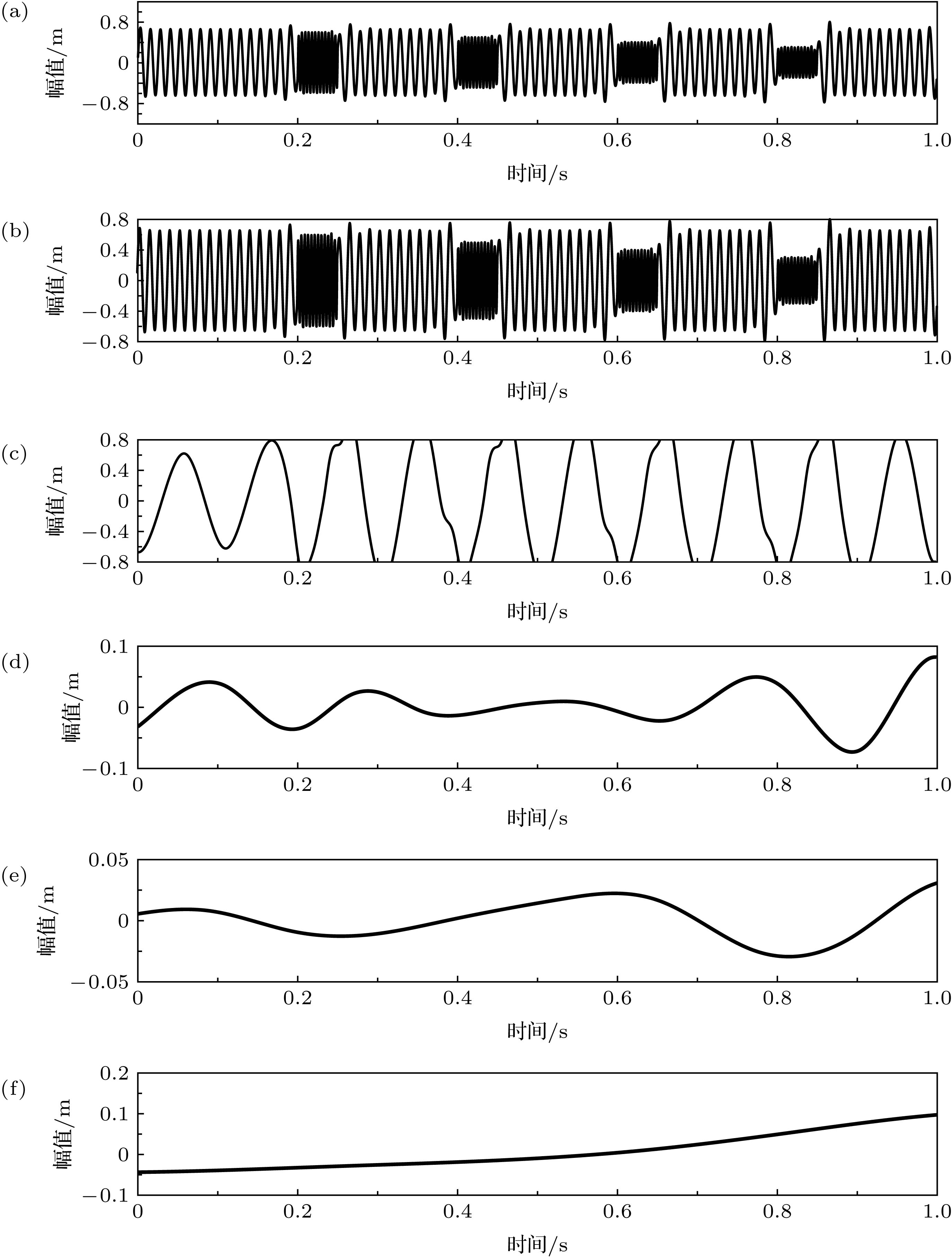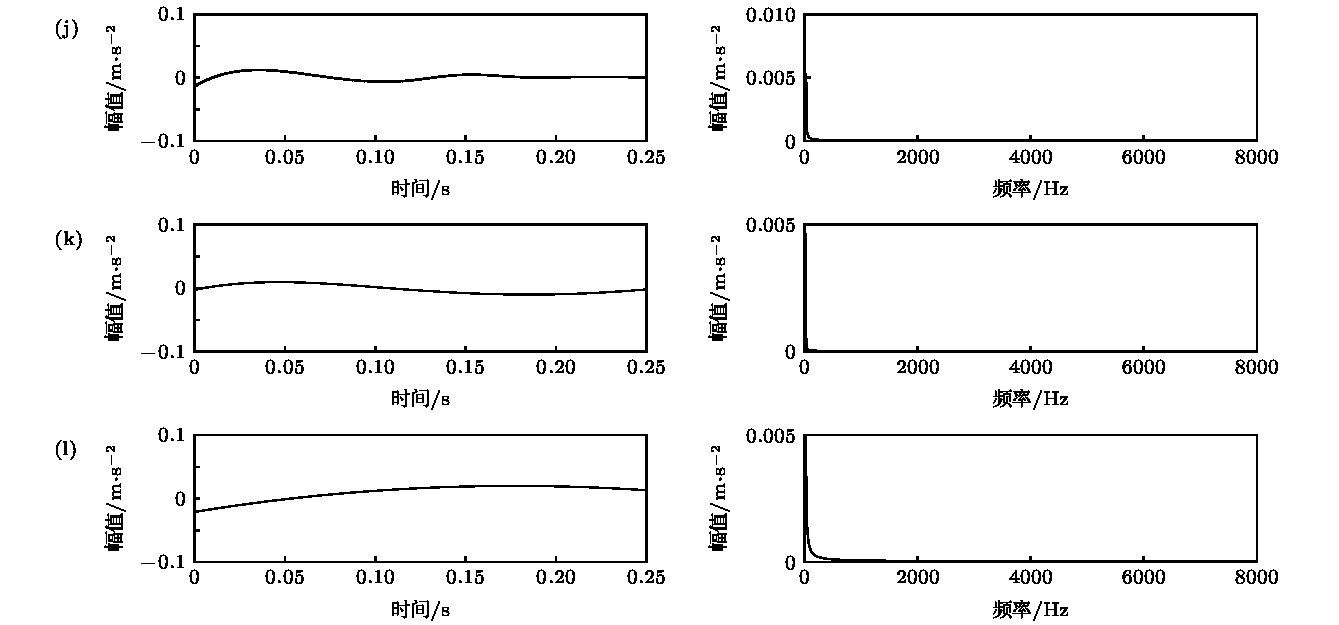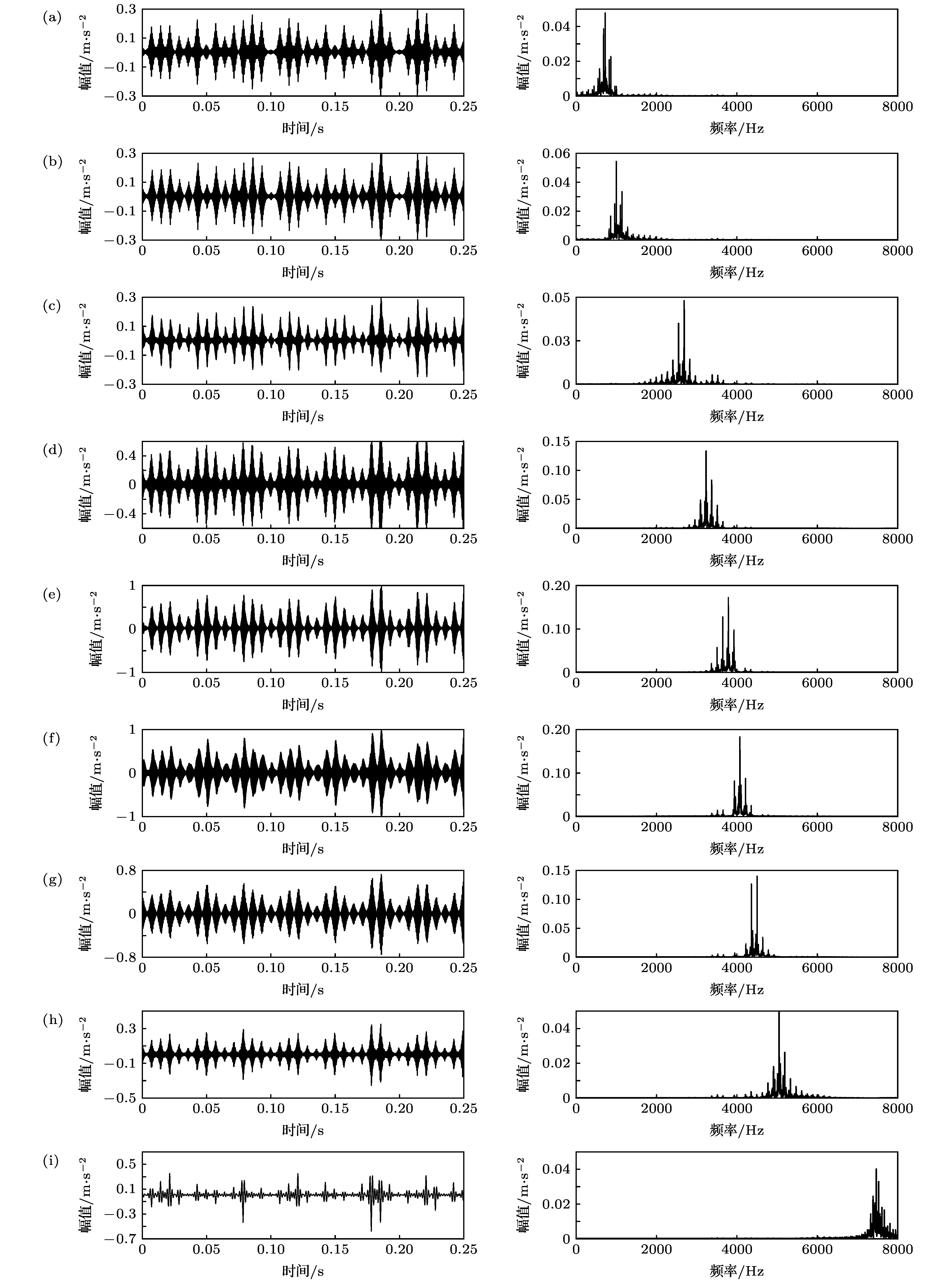-
经验模态分解一类的递归算法所产生的模态混淆和端点效应将导致所获物理信息失真, 变分模态分解可改善这些问题. 但因其需预设参数, 对信号分解精度影响显著, 为此, 提出采用目标信号功率谱峰值所对应的频率以初始化变分模态分解所需中心频率, 借鉴经验模态分解递归模型, 基于能量截止法将变分模态分解改进为递归模式算法, 并采用粒子群优化算法对具有带宽约束能力的惩罚因子进行最优取值, 构成优化递归变分模态分解. 通过对比分析经验模态分解, 集成经验模态分解及优化递归变分模态分解在分解信号时的计算精度; 研究传统变分模态分解与优化递归变分模态分解在处理实际振动信号时计算速率. 结果表明: 优化递归变分模态分解在处理目标信号时精度最高, 与原分量相关性达99.9%; 与集成经验模态分解对比, 可由低至高将信号分解至不同频段, 物理意义更加清晰且不产生虚假模态; 处理实际非线性信号时, 优化递归变分模态分解无需预设分解模态个数, 相比于传统变分模态分解, 计算速率高12.5%—18.5%.Variational mode decomposition can improve traditional recursive algorithms, such as empirical mode decomposition, resulting modal aliasing and endpoint effects, but it has a significant influence on signal decomposition accuracy due to its pre-set parameters. The frequency corresponding to the peak value of the target signal power spectrum is proposed to initialize the center frequency required for the variational mode decomposition. The empirical mode decomposition and recursive model is used to improve the variational mode decomposition into the recursive mode algorithm based on the energy cutoff method. The group optimization algorithm optimally takes the penalty factor with bandwidth constraint ability to form an optimized recursive variational mode decomposition. By comparing with and analyzing empirical mode decomposition, integrating empirical mode decomposition and optimizing the computational accuracy of recursive variational mode decomposition in decomposing signals; studying traditional variational mode decomposition and optimizing recursive variational mode decomposition in dealing with actual vibration signals calculating rate, the results are obtained, showing that the optimized recursive variational mode decomposition has the highest accuracy when dealing with the target signal, and the correlation with the original component is 99.9%. Comparing with the integrated empirical mode decomposition, the signal can be decomposed into different frequency bands from low to high, and the physical meaning is clearer. No false modality is generated. When the actual nonlinear signal is processed, the optimized recursive variational mode decomposition does not need to preset the number of decomposition modes, and the calculation rate is 12.5%–18.5% higher than thay of the traditional variational mode decomposition.
-
Keywords:
- variational mode decomposition /
- nonlinear /
- signal process
[1] Ingerman E A, London R A, Heintzmann R, Gustafsson M G L 2019 J. Microsc. 273 11
[2] Banjade T P, Yu S, Ma J 2019 J. Seismol. 5 1
[3] Yang F, Shen X, Wang Z 2018 Entropy 20 8
[4] Lian J J, Zhuo L, Wang H J, Dong X F 2018 Mech. Syst. Sig. Process. 107 53
 Google Scholar
Google Scholar
[5] Klionskiy D M, Kaplun D I, Geppener V V 2018 Pattern Recognit Image Anal. 28 122
 Google Scholar
Google Scholar
[6] Chervyakov N, Lyakhov P, Kaplun D, Butusov D, Nagornov N 2018 Electronics 8 135
[7] Qiu X, Ren Y, Suganthan P N, Amaratunga G A J 2017 Appl. Soft Comput. 54 246
 Google Scholar
Google Scholar
[8] Sweeney K T, Mcloone S F, Ward T E 2013 IEEE Trans. Biomed. Eng. 60 97
 Google Scholar
Google Scholar
[9] Guo Y, Naik G R, Nguyen H 2017 IEEE Eng. Med. Biol. Soc. 2013 6812
[10] Wang Y, Liu F, Jiang Z S, He S L, Mo Q Y 2017 Mech. Syst. Sig. Process. 86 75
 Google Scholar
Google Scholar
[11] Xiong T, Bao Y, Zhongyi H U 2014 Neurocomputing 123 174
 Google Scholar
Google Scholar
[12] Dragomiretskiy K, Zosso D 2014 IEEE Trans. Sig. Process. 62 531
[13] Wang Y X, Markert R, Xiang J W, Zheng W G 2015 Mech. Syst. Sig. Process. 60 243
[14] Yang F R, Bi X, Li C C, Liu C F, Tian T 2019 Measurement 140 1
 Google Scholar
Google Scholar
[15] 郑小霞, 陈广宁, 任浩翰, 李东东 2019 振动与冲击 38 153
Zheng X X, Chen G N, Ren H H, Li D D 2019 J. Vib. Shock 38 153
[16] 唐贵基, 王晓龙 2015 西安交通大学学报 49 73
 Google Scholar
Google Scholar
Tang G J, Wang X L 2015 J. Xi'an Jiaotong Univ. 49 73
 Google Scholar
Google Scholar
[17] 刘备, 胡伟鹏, 邹孝, 丁亚军, 钱盛友 2019 68 028702
 Google Scholar
Google Scholar
Liu B, Hu E P, Zou X, Ding Y J, Qian S Y 2019 Acta Phys. Sin. 68 028702
 Google Scholar
Google Scholar
[18] Baldini G, Steri G, Dimc F, Giuliani R 2016 Sensors 16 818
 Google Scholar
Google Scholar
[19] Chen X J, Yang Y M, Cui Z X, Shen J 2019 Energy 174 1110
 Google Scholar
Google Scholar
[20] Cui J, Yu R Z, Zhao D B, Yang J Y, Ge W C, Zhou X M 2019 Appl. Energy 247 480
 Google Scholar
Google Scholar
[21] Huang N E, Shen Z, Long S R 1998 Proc. Roy. Soc. A 454 903
 Google Scholar
Google Scholar
[22] Damerval C, Meignen S, Valerie P 2005 IEEE Signal Process Lett. 12 701
 Google Scholar
Google Scholar
[23] Cheng J S, Yu D J, Yang Y 2006 Mech. Syst. Sig. Process. 20 817
 Google Scholar
Google Scholar
[24] Kennedy J, Eberhart R 1995 IEEE Int. Conf. Neural Networks 4 1942
[25] 吕中亮 2016 博士学位论文(重庆: 重庆大学)
Lv Z L 2016 Ph. D. Dissertation (Chongqing: Chongqing University) (in Chinese)
[26] Mcfadden P D, Smith J D 1984 J. Sound Vib. 96 69
 Google Scholar
Google Scholar
[27] Smith W A, Randall R B 2015 Mech. Syst. Sig. Process. 64–65 100
 Google Scholar
Google Scholar
[28] Chen F, Shi T, Duan S K, Wang L D, Wu J G 2017 Signal Process. 142 423
[29] Chen F, Li X Y, Duan S K, Wang L D, Wu J G 2018 Digit. Signal Prog. 81 16
 Google Scholar
Google Scholar
[30] Chen F, Shao X D 2017 Signal Process. 133 213
 Google Scholar
Google Scholar
[31] Shao X D, Chen F 2019 Signal Process. 160 237
 Google Scholar
Google Scholar
-
图 8 故障信号EEMD分解结果 (a) IMF1; (b) IMF2; (c) IMF3; (d) IMF4; (e) IMF5; (f) IMF6; (g) IMF7; (h) IMF8; (i) IMF9; (j) IMF10; (k) IMF11; (l) IMF12
Fig. 8. The results of EEMD for fault signal: (a) IMF1; (b) IMF2; (c) IMF3; (d) IMF4; (e) IMF5; (f) IMF6; (g) IMF7; (h) IMF8; (i) IMF9; (j) IMF10; (k) IMF11; (l) IMF12.
表 1 ORVMD参数组合
Table 1. Parameter set of ORVMD.
编号 K, α 编号 K, α 1 12, 12100 14 12, 12400 2 12, 12900 15 12, 12000 3 12, 11800 16 12, 12000 4 12, 11900 17 13, 11900 5 12, 11800 18 12, 11900 6 12, 12700 19 12, 11400 7 12, 12100 20 12, 11900 8 12, 13100 21 13, 11900 9 12, 12100 22 12, 11900 10 12, 12000 23 12, 12000 11 11, 12000 24 12, 12000 12 11, 12000 25 11, 12100 13 12, 13200 — — -
[1] Ingerman E A, London R A, Heintzmann R, Gustafsson M G L 2019 J. Microsc. 273 11
[2] Banjade T P, Yu S, Ma J 2019 J. Seismol. 5 1
[3] Yang F, Shen X, Wang Z 2018 Entropy 20 8
[4] Lian J J, Zhuo L, Wang H J, Dong X F 2018 Mech. Syst. Sig. Process. 107 53
 Google Scholar
Google Scholar
[5] Klionskiy D M, Kaplun D I, Geppener V V 2018 Pattern Recognit Image Anal. 28 122
 Google Scholar
Google Scholar
[6] Chervyakov N, Lyakhov P, Kaplun D, Butusov D, Nagornov N 2018 Electronics 8 135
[7] Qiu X, Ren Y, Suganthan P N, Amaratunga G A J 2017 Appl. Soft Comput. 54 246
 Google Scholar
Google Scholar
[8] Sweeney K T, Mcloone S F, Ward T E 2013 IEEE Trans. Biomed. Eng. 60 97
 Google Scholar
Google Scholar
[9] Guo Y, Naik G R, Nguyen H 2017 IEEE Eng. Med. Biol. Soc. 2013 6812
[10] Wang Y, Liu F, Jiang Z S, He S L, Mo Q Y 2017 Mech. Syst. Sig. Process. 86 75
 Google Scholar
Google Scholar
[11] Xiong T, Bao Y, Zhongyi H U 2014 Neurocomputing 123 174
 Google Scholar
Google Scholar
[12] Dragomiretskiy K, Zosso D 2014 IEEE Trans. Sig. Process. 62 531
[13] Wang Y X, Markert R, Xiang J W, Zheng W G 2015 Mech. Syst. Sig. Process. 60 243
[14] Yang F R, Bi X, Li C C, Liu C F, Tian T 2019 Measurement 140 1
 Google Scholar
Google Scholar
[15] 郑小霞, 陈广宁, 任浩翰, 李东东 2019 振动与冲击 38 153
Zheng X X, Chen G N, Ren H H, Li D D 2019 J. Vib. Shock 38 153
[16] 唐贵基, 王晓龙 2015 西安交通大学学报 49 73
 Google Scholar
Google Scholar
Tang G J, Wang X L 2015 J. Xi'an Jiaotong Univ. 49 73
 Google Scholar
Google Scholar
[17] 刘备, 胡伟鹏, 邹孝, 丁亚军, 钱盛友 2019 68 028702
 Google Scholar
Google Scholar
Liu B, Hu E P, Zou X, Ding Y J, Qian S Y 2019 Acta Phys. Sin. 68 028702
 Google Scholar
Google Scholar
[18] Baldini G, Steri G, Dimc F, Giuliani R 2016 Sensors 16 818
 Google Scholar
Google Scholar
[19] Chen X J, Yang Y M, Cui Z X, Shen J 2019 Energy 174 1110
 Google Scholar
Google Scholar
[20] Cui J, Yu R Z, Zhao D B, Yang J Y, Ge W C, Zhou X M 2019 Appl. Energy 247 480
 Google Scholar
Google Scholar
[21] Huang N E, Shen Z, Long S R 1998 Proc. Roy. Soc. A 454 903
 Google Scholar
Google Scholar
[22] Damerval C, Meignen S, Valerie P 2005 IEEE Signal Process Lett. 12 701
 Google Scholar
Google Scholar
[23] Cheng J S, Yu D J, Yang Y 2006 Mech. Syst. Sig. Process. 20 817
 Google Scholar
Google Scholar
[24] Kennedy J, Eberhart R 1995 IEEE Int. Conf. Neural Networks 4 1942
[25] 吕中亮 2016 博士学位论文(重庆: 重庆大学)
Lv Z L 2016 Ph. D. Dissertation (Chongqing: Chongqing University) (in Chinese)
[26] Mcfadden P D, Smith J D 1984 J. Sound Vib. 96 69
 Google Scholar
Google Scholar
[27] Smith W A, Randall R B 2015 Mech. Syst. Sig. Process. 64–65 100
 Google Scholar
Google Scholar
[28] Chen F, Shi T, Duan S K, Wang L D, Wu J G 2017 Signal Process. 142 423
[29] Chen F, Li X Y, Duan S K, Wang L D, Wu J G 2018 Digit. Signal Prog. 81 16
 Google Scholar
Google Scholar
[30] Chen F, Shao X D 2017 Signal Process. 133 213
 Google Scholar
Google Scholar
[31] Shao X D, Chen F 2019 Signal Process. 160 237
 Google Scholar
Google Scholar
计量
- 文章访问数: 15866
- PDF下载量: 302
- 被引次数: 0














 下载:
下载:









